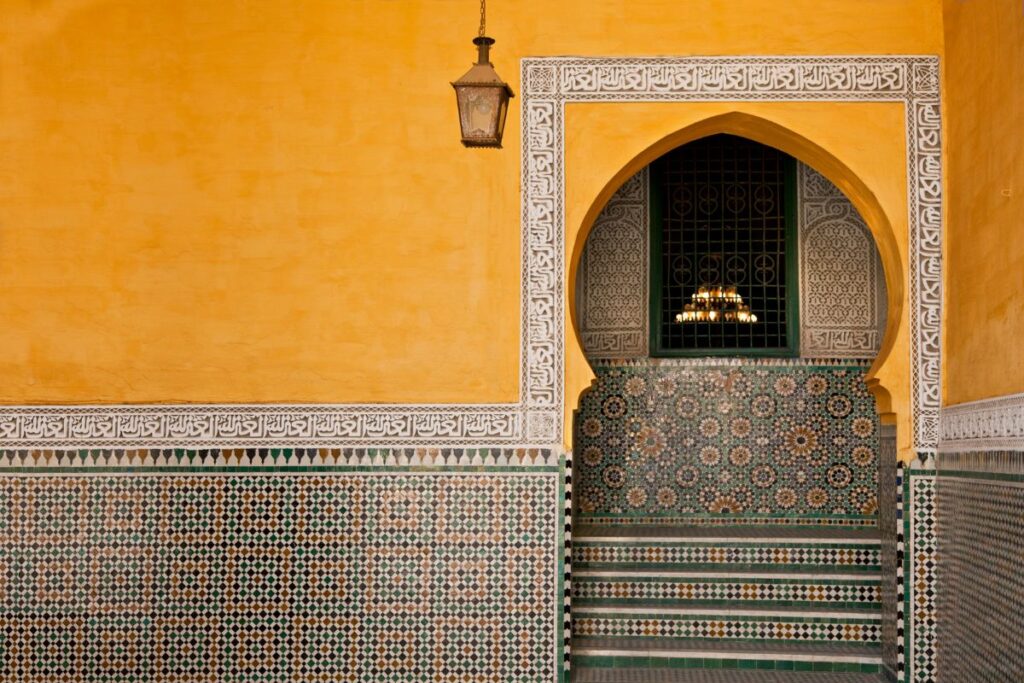
What to do and see in Meknes, Meknes, also known as Meknès, is a city in Morocco named after the Berber tribe that originally founded it as Meknassi. As the administrative capital of the Meknès-Tafilalet region and one of the country’s four imperial cities, Meknes boasts a central location in the north of Morocco. Located 138 km east of Rabat and 60 km west of Fes, the city offers a strategic base for exploring this part of the country. Whether you’re interested in history, culture, or natural beauty, Meknes has something to offer visitors of all interests.
What to do and see in Meknes medina
Meknes is closely associated with the reign of the remarkable sultan Moulay Ismail, who ruled for 55 years as the second leader of the Alaoui dynasty. During his time in power, Moulay Ismail declared Meknes his capital, and the city quickly grew in stature, becoming a monumental city on par with Rabat and Marrakech. Today, Meknes is known as the ‘Moroccan Versailles’ and boasts a wealth of historical monuments and natural sites, including more than 40 km of imposing defensive walls and numerous mosques.
The city is called the ‘City of a Hundred Minarets’ due to its numerous minarets. Moreover, Meknes is the closest city to the Roman ruins of Volubilis (Oualili). With reasonable prices and friendly locals, Meknes is a fantastic destination for anyone looking to explore Morocco.
Meknes Travel
Meknes is an imperial city easily accessible by train and highway, making it a convenient stop for those traveling from Tangier to Fes, for those who arrive in the city in the afternoon, spend the night in Meknes and take a day trip to Fes, the following day is recommended. This allows visitors to fully appreciate the many sights and experiences that both cities have to offer.
What to do and see in Meknes: day trip
Visitors can come to this city by bus. The best way to get around Meknes is by taxi. Getting around is not a problem for any of the visitors that come here. Travelers can visit most of the tourist attractions here, unlike the neighboring city of Fes. There are many things to do in Meknes and visitors will always find something to keep themselves occupied.
What to see in Meknes
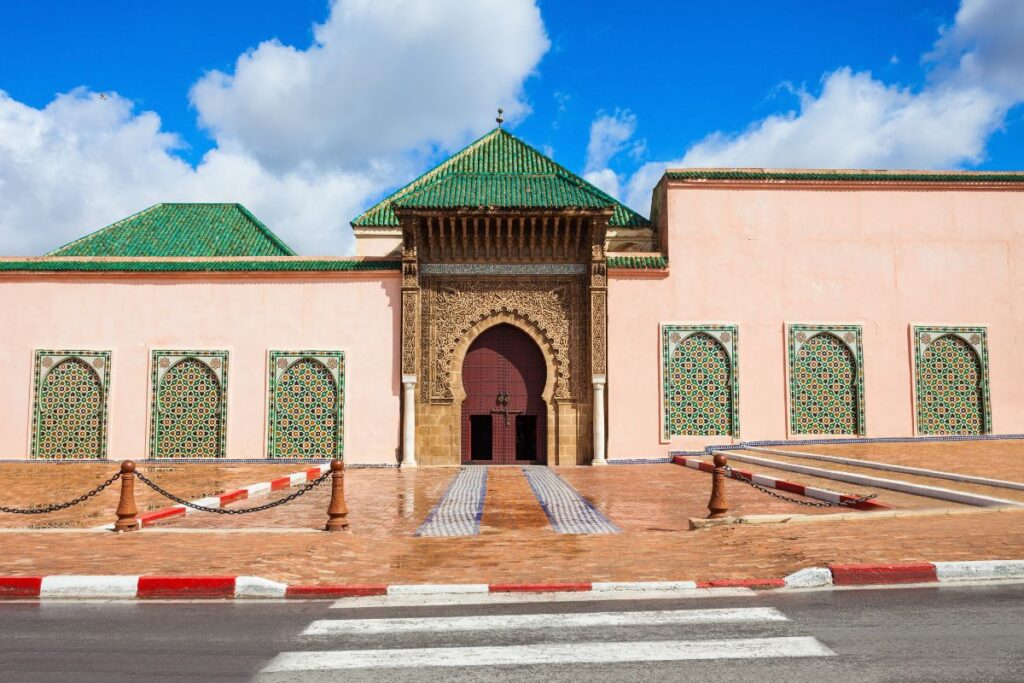
In addition to exploring the walls, wandering through the medina, and bargaining in the souks, visitors to Meknes can also enjoy a variety of other sights and experiences. Highlights include the Mausoleum of Mulay Ismail, the Bab El Mansur, Bab Berdain, and Bab El-Jemis gates, the Adgal pond, the Medersa Bou Inania, the stunning Gardens of the Sultans, the granaries (Heri es-Suani), the big stables, and the Moroccan Art Museum in Dar Jamai. With so much to see and do, Meknes is a must-visit destination for anyone traveling in Morocco.
Meknes attractions
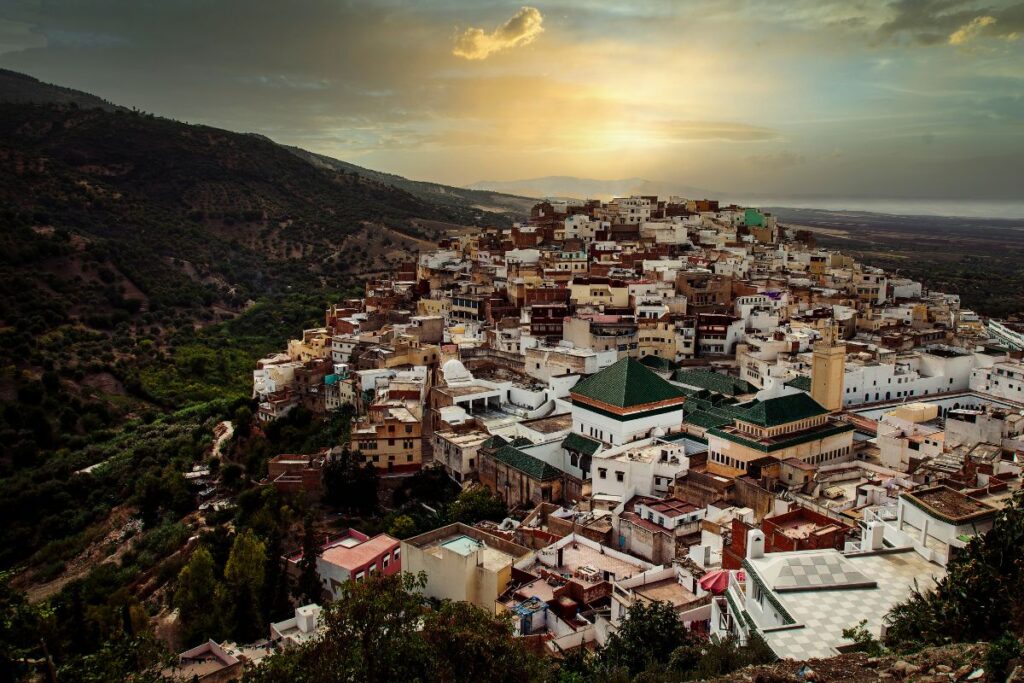
In the vicinity of Meknes (26 km) stands Moulay Idriss. This city is the scene of one of the busiest mousses. Every year, in August and September, thousands of pilgrims go to Moulay Idriss, attracting interested travelers and giving rise to a lively event with many traditional colors.
27 km from Meknes are the ruins of the Roman city of Volubilis, the residence of the procurators of Mauritania Tingitana, from the 1st century AD
Religious places to see in Meknes
Mausoleum of Moulay Ismail
Built by Ahmed Eddahbi, it is located in the medina, on the opposite side of the square and Hedim. It is the final resting place of one of Morocco’s most famous sultans. It is one of the three Moroccan shrines, along with the tomb of the Mohamed V University of Rabat and the Medersa Bou Inania in Fes, which non-Muslims can visit. As a curiosity, Moulay Ismail had some 888 children conceived by his more than 550 wives and more than 4000 concubines.
Yet, he tried several times to marry the daughter of Louis XIV, Anne Mary of Bourbon, thanks to the good relations between the two leaders.
Access to the mausoleum of Moulay Ismail
Access to the mausoleum’s interior for people who do not process the Muslim religion is limited, as everything but the sultan’s remains can be accessed. To enter the mausoleum, you must respect the rules of courtesy and wear moderate attire for Muslims. It is accessed through elegant and sober patios, with minimally decorated rooms based on zellij tiles and plasterwork.
Moroccan Mosaic Tiles
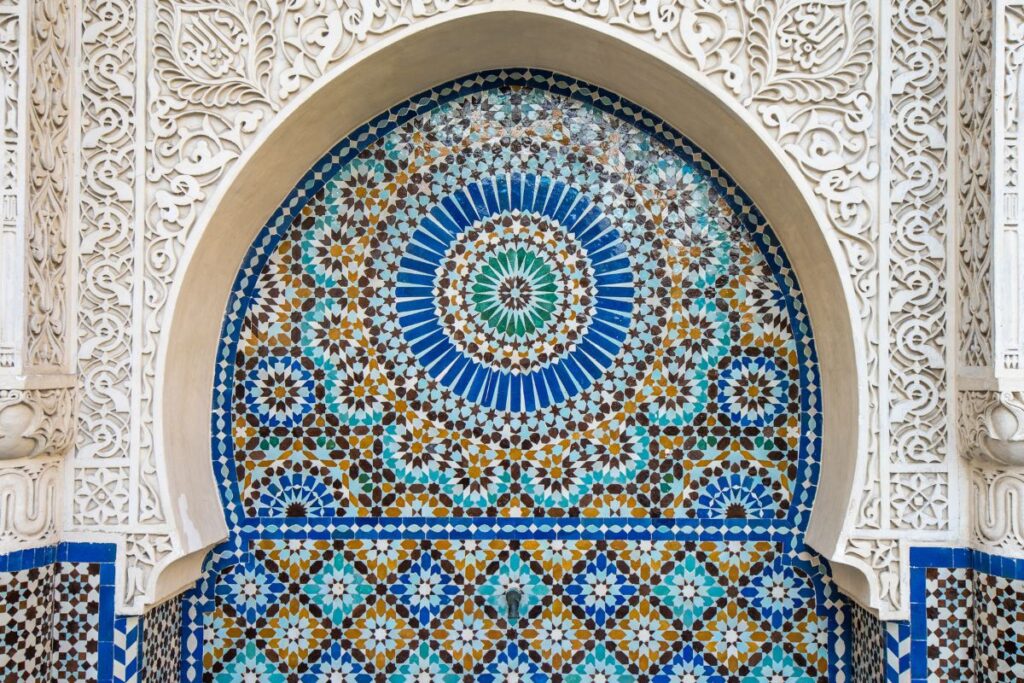
The core of the shrine, however, is a richly decorated room with many Islamic motifs of great beauty and a fountain located in the center. Moulay Ismail was buried here with one of his five wives and two of his more than eight hundred children. Many Moroccans visit Moulay Ismail’s mausoleum, believing it possesses the power to heal.
Nejjarine Mosque: erected in the 10th century. It is located in the heart of the Meknes Medina.
The Grand Mosque was probably founded in the eleventh century by the Almoravids. It stands out for its 11 doors and 143 arches, and beautifully sculpted roofs.
Jamai Roua Mosque: built in 1790 by Sidi Mohamed Ben Abdellah.
Sheikh Kamel Mausoleum: built by Sidi Mohamed Ben Abdellah, which houses the tomb of El Hadi Benaissa, founder of the “Aissaúas.”
Museums and medersas to visit in Meknes
Dar Jamai Museum: a place that reflects the taste of Morocco’s upper class. At the end of the 19th century, it became a museum of Moroccan and ethnographic arts.
Medersa Bouanania: Institute of Theology, founded by Sultan Abu Hassan Marini (1331-1351). It has a patio and a 26-room flat. It has very good examples of zellige mosaics and wood carvings. This masterpiece of the Hispano-Moorish style is built according to the plans of the classical school of the Koran. It has a central courtyard surrounded by a gallery, a prayer room, and a first floor composed of rooms for students.
Medersa Filalia: historic building for educational and religious activities. Built-in 1789 by Moulay Ismail
Historical monuments to see in Meknes
Al Koubat Khayatine (Ambassador’s Room): pavilion in which Sultan Mulay Ismail received foreign ambassadors and emissaries
Bab Lakhmis: the large ornate door of the seventeenth century
Bab Berdaine: Majestic gate built by Moulay Ismail in the 17th century
Dar El Beida: 19th-century Alaouite palace built by Sultan Sidi Mohamed Ben Abdellah. Today it houses the Royal Military Academy of Meknes
The Fandouk Hanna: cultural complex. Property of the endowments
Ksar Mansour: public domain palace and barn
Las Haras: created in 1914 as an institution, it goes back to the military. In 1947 it became a center for horse breeding.
Barn and stable: gigantic architectural complex built by Moulay Ismail. It is reserved for food storage.
Bassin Agdal: large water storage pond with 319 m in length and 149 m in width. Its depth exceeds 2 m. The Moulay Ismael built it to irrigate the gardens of Mekinez.
Qara Prison: the prison (underground silo) is named for Cara, a Portuguese architect, and prisoner.
The most famous historical monuments of Meknes
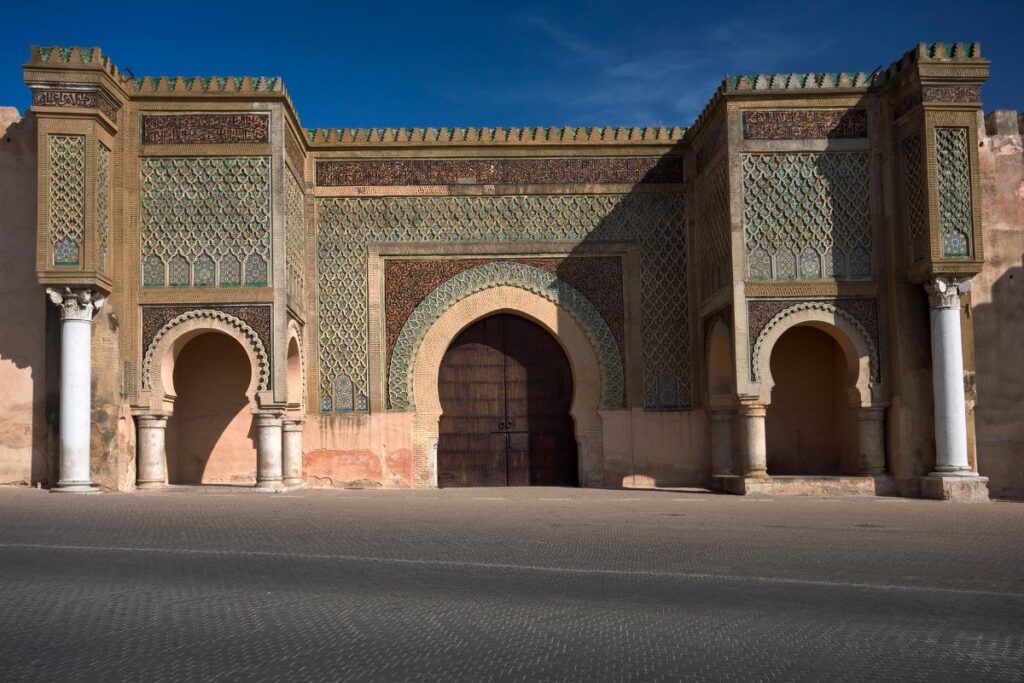
The palace of Dar El Makhzen: is located in the urban area of El Mechouar Stinia. It is surrounded by a 2 km corridor formed by two impressive walls. It was the official palace of Moulay Ismail.
Bab Mansour is considered one of the most beautiful doors in the world. The gate was completed in 1732 by Mulay Abdallah, son of Mulay Ismail, the sultan with the greatest influence in the history of Morocco. The proportions of this door are majestic.
This gate connected the El Hedim square and, by extension, the Meknes medina with the Lalla Auda square in the Dar el Kbir fortress. It represents the power of this imperial city. Bab Mansour is the largest gate in Morocco and even North Africa. Bab el Mansour was completely renovated in the nineties. Restoration work enhanced the dark green color, characteristic of the imperial city of Meknes.
Lahboul Garden: located in the urban area of Medina Al-Ismailia. It contains a zoo and an open-air theater.
Real Golf: it is inside the walls of Moulay Ismail. It consists of 9 holes. The sport is practiced with artificial light.
Plaza de el El Hédime: means “Square of the ruins”. This vast esplanade is essential for accessing the souks, a picturesque square of great dimensions in front of Bab Mansour, the meeting point of the medina and the imperial city of Meknes. It reminds us a little of the Jemaa square, the Fnaa of Marrakech. It is a rectangular square surrounded by buildings more homogeneous than his older sister in Marrakech. Around this square are many restaurant terraces.
It is a magnificent place to enjoy Moroccan tea while contemplating the square’s life. In it, we find diverse people, from vendors, acrobats, storytellers, and tourists … who gather around this square at nightfall. A food souk surrounds the south side of the square.
Where to Eat in Meknes
The New City
Dozens of restaurants and bars line the main road of Antsirabi street and offer harira, tajine, couscous, and roast chicken. Some restaurants on Rue de Ghana, just off Rue Antsirabi, are popular with travelers and offer menus at 40 Dh.
Le Pub, Allal Ben Abdellah street. Open every day until midnight. Excellent, although a bit experimental, is French cuisine. The pizza is not bad and it has an alcohol license. 50 Dh -120 Dh.
Athenos, Mohamed V street. Open for lunch. Delicious Moroccan dishes, such as tajine, as well as fabulous desserts. 25 Dh-70 Dh.
Mo Di Niro, Antsirabé street. Open every day until midnight. This restaurant is popular with teenagers and offers American-style food: hamburgers, pizzas, and pasta. 20-100 Dh 20-100 Dh
The Fine Bouche, Avenida Allal Ben Abdellah. Open every day until 10 pm. They serve delicious chawarmas and other specialties. 15-50 Dh.
Ibis Hotel. This hotel chain has a decent menu of French food, but the real attraction is that they serve alcohol .50-150 dh
Label ‘Gallery. Several restaurants, some open after midnight. It is the closest thing to a shopping center, the only place to find international cuisines, such as Mexican, American, Thai, and Lebanese. Prices vary a lot.
Marhaba: the most popular Meknassi restaurant, offers a local menu of Ma’aqouda and Harira.
In the Meknes medina
Les Colliers de Colombe, 67 street driba. Follow the signs that are behind Lalla Aouda, near the medina. Open every day. Delicious Moroccan dishes, including the Bastilla. Prices vary. Most dishes are more than 100 Dh.
The market near the main square of the medina, in the neighborhood of Bab El-Mansur, has good fresh products and a lot of different types of olives, sweets … etc.
History of Meknes
Meknassa Ez-Zeitoun (Meknasa of Olives) is a Berber foundation of the 9th century. Still, it was not until 1069 that it took its true character when the Almoravids built a bastion and a citadel. After going through multiple sieges, conquests, abandonment, and reconstructions, Meknes reached its apogee under the reign of Moulay Ismail.
This Sultan of Alawi, a contemporary of King Sol, Louis XIV of France, embellished Meknes by providing walls with monumental doors, gardens, mosques, Alcazabas, and his first palace, Dar Kebira. The result is one of the most beautiful and fascinating cities in Morocco.
Meknes Facts
The Alaouite Sultan Moulay Ismail is the city’s bloodiest chapter. If their important monuments and more than 40 km of defensive walls spoke, they would tell us stories of beheadings, concubines, and servitude. They would speak of immense armies of Christian slaves. They would speak, in short, Alaouite Ismail Ibn Sharif, ‘the warrior king’.
He succeeded his brother on the throne, Al-Rachid, who could not recover from his serious injuries after falling off his horse. Ismail found a country weakened by internal wars. Upon arrival at the sultanate, Ismail moved the capital from Fes to Meknes.
He ordered to surround of the city with its famous walls and build a gigantic palace, raised by an army of more than 25,000 slaves, obtained mostly in pirate assaults on European ships. He succeeded in reuniting most of the tribes and expelled the foreigners settled on the coast. He used the Black Guard, a fearsome army of more than 100,000 Sudanese slaves.
Ismail, remembered as one of the bloodthirsty sultans in history, was more feared than wanted … From Meknes, Sultan Ismail fought with an iron fist to consolidate the borders of the emerging state of Morocco against the Ottoman siege from Algeria. Also, against European interference, snatching the cities of Tangier from the English and Larache and Mamoura from the Spaniards.
What to do and see in Meknes: Nightlife
For some strange reason, Meknes seems to have more bars than people, although only a few suit the traveler.
Le Pub, Allal Ben Abdellah Avenue. Open every day until midnight. One of the few places in Meknes where women feel comfortable for a drink. This lively pub has two floors. The price is 15-45 Dh, and beer bottles and cocktails are 50 Dh. Try the wines of the land: Guerrouane and Amazir are particularly tasty, and the Shisha (water pipe with tobacco) costs 50 Dh.
The novelty, above the street of Paris. Open every day until midnight. It is rumored that this bar’s recently renovated owners are Italians, which would explain the decoration. It is also the only place in Mekinez to drink beer on tap. 15 Dh-45 Dh bottles of beer, cocktails 50 Dh. The wine is served in the bottle only.
Hotel Zaki is open late. The only place to drink outdoors is Meknes.
Buy in Meknes
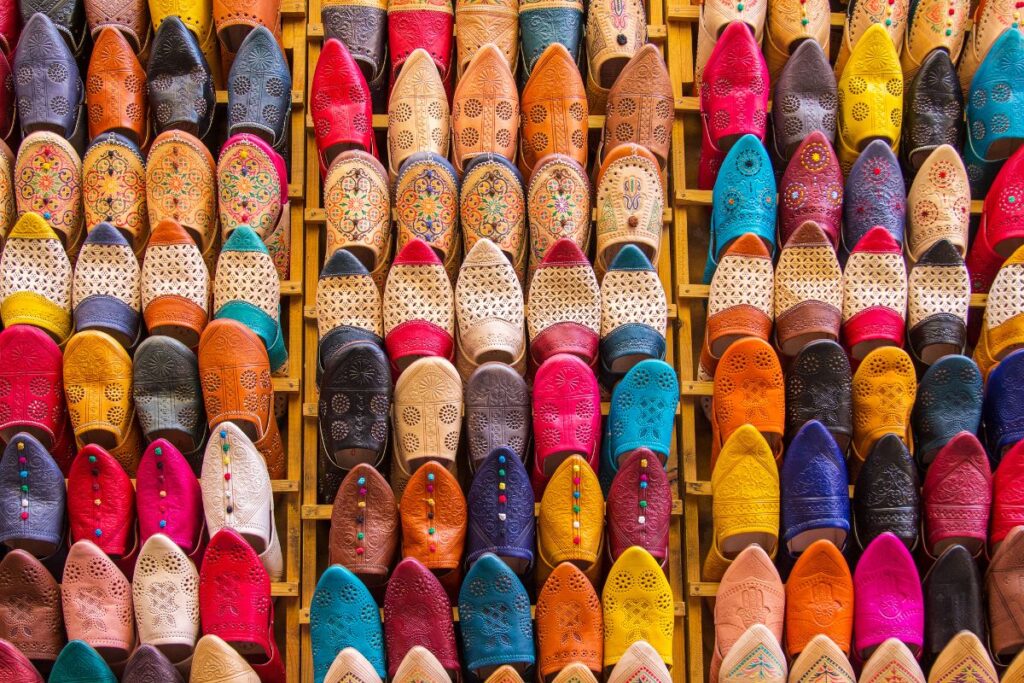
This city is not a paradise for those who love shopping, but it is cheaper than Fes. The medina contains traditional Moroccan clothes, rugs, and the popular Moroccan footwear: Bilgha. It is also known for its iron and for articles made to the local craft specialty. In the back of Hedim, next to Dar Jamai, you will find many shops for tourists.
Make sure you accept a reasonable price, do not accept the first offer from the merchant. The simplest way to haggle, especially without knowledge of French or Arabic, is to offer exactly half the price (or 75% of expensive or large-scale items). From there, the shopkeeper will go down until an agreement is reached.
If you can not get an agreement, decide to leave: as a general rule, it will lower the price significantly. And try not to be too stingy.
Surroundings of Mekines
The Roman ruins of Volubilis (Oualili in Arabic and Berber): it is a World Heritage Site by UNESCO and is very close to the city.
Moulay Idriss Zerhoun: is located 14 km from Meknes and right next to Volubilis. The small town is located on a hill, was founded by Moulay Idriss I, and is a sacred place for Muslims. A museum is held here every year.
What is Meknes known for?
Meknes is known for its well-preserved historic old town, once Morocco’s capital.
Is Meknes a safe city to visit?
Meknes is generally considered a safe city for tourists, but it’s always a good idea to exercise caution and be aware of your surroundings.
What is the best time of year to visit Meknes?
The best time of year to visit Meknes is during the spring or fall when the weather is mild and comfortable.
What is the Meknes Medina?
The Meknes Medina is the historic old town of Meknes, filled with narrow alleyways, traditional souks, and historic buildings.
What is the best way to get around Meknes?
The best way to get around Meknes is by foot, as many of the top attractions are located in the historic old town, which is pedestrian-friendly.
What is the historical significance of Meknes?
Meknes was once the capital of Morocco and is known for its well-preserved imperial architecture.
What is the natural beauty of Meknes?
Meknes is surrounded by beautiful countryside and has several parks and gardens, including the Bou Inania Medersa Garden and the El Hedim Park.
What is the Mellah neighborhood in Meknes?
The Mellah neighborhood is a historically Jewish area in Meknes that features a beautiful synagogue, historic buildings, and a bustling market.
What is the most famous attraction in Meknes?
The most famous attraction in Meknes is the Bab Mansour gate, considered one of Morocco’s most beautiful gates.
What is the El Maadena district in Meknes?
The El Maadena district is a historic area in Meknes that features narrow alleys, traditional buildings, and the famous Place Lalla Aouda, a picturesque square with a fountain.

